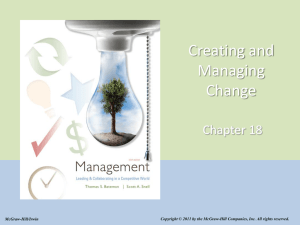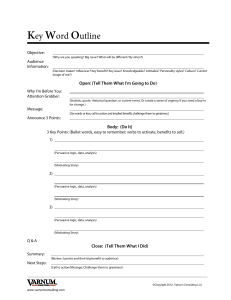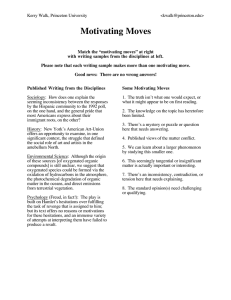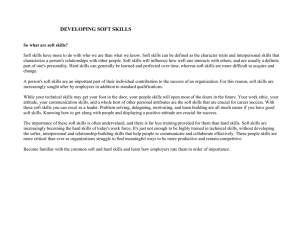Session 13 CREATING AND MANAGING CHANGE – Manajemen Umum
advertisement
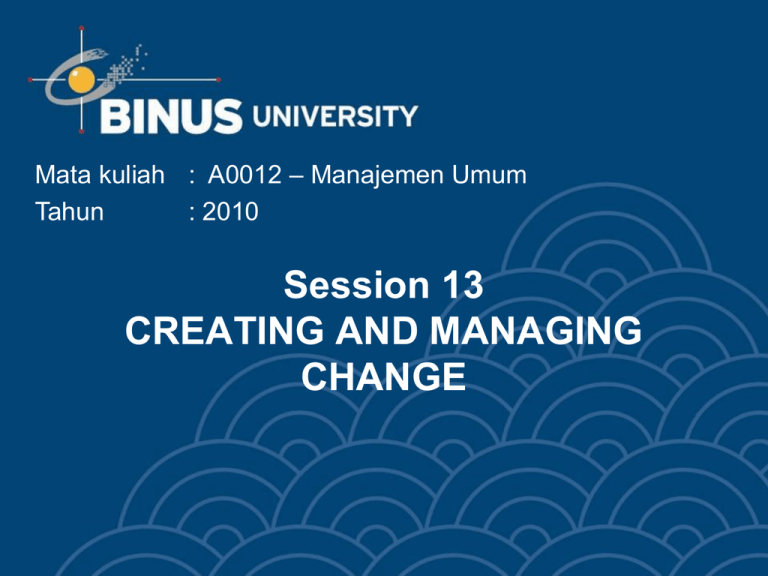
Mata kuliah : A0012 – Manajemen Umum Tahun : 2010 Session 13 CREATING AND MANAGING CHANGE Learning Objectives • After studying Chapter 18, you will know: – what it takes to be world class – how to manage change effectively – how to best prepare for the future 18-2 Outline Materi • • • Bina Nusantara Becoming World Class Managing Change Shaping the Future Becoming World Class • Sustainable, great futures – essential characteristics of enduringly great companies • strong core values • driven by stretch goals • change continuously – drive for progress via adaptability, experimentation, trial and error, opportunistic thinking, and fast action • focus primarily on beating themselves – in sum, great companies have core values, know what they are and what they mean, and live by them 18-4 Becoming World Class (cont.) • The tyranny of the ‘or” – the belief that things must be either A or B, and cannot be both – belief that only one goal but not another can be attained – often is invalid • always is constraining • The genius of the “and” – ability to pursue multiple goals at once • • • • 18-5 deliver multiple competitive values to customers perform all management functions reconcile hard-nosed business logic with ethics lead and empower Managing Change • Organizational change is managed effectively when: – organization is moved from its current state to a planned future state – the change works as planned – the transition is accomplished without excessive costs to the organization or to individual organizational members • People are the key to successful change – people must take an interest and active role in helping the organization as a whole – permanent rekindling of individual creativity and responsibility should be a consequence of change 18-6 Managing Change (cont.) • Motivating people to change – people must be motivated to change • people often resist change – General reasons for resistance • Inertia - people don’t want to disturb the status quo • Timing - managers should introduce change when people are receptive • Surprise - resistance is likely when change is sudden, unexpected, or extreme • Peer pressure - work teams may band together in opposition to change 18-7 Managing Change (cont.) • Motivating people to change (cont.) – Change-specific reasons for resistance • Self-interest - care less about the organization’s best interest than they do about their own best interests • Misunderstanding - people may resist because they don’t fully understand the purpose of the change • Different assessments - employees receive different - and usually less information than management receives – such discrepancies cause people to develop different assessments of proposed changes 18-8 Implementing Change Unfreezing (breaking from the old ways of doing things) 18-9 Moving (instituting the changes) Refreezing (reinforcing and supporting the new ways) Managing Change (cont.) • Motivating people to change (cont.) – General model for managing resistance • Unfreezing - realizing that current practices are inappropriate and the new behavior must be enacted – performance gap - important contributor to unfreezing » the difference between actual performance and the performance that should or could exist » can apply to the organization as a whole or to departments, groups, or individuals • Moving - instituting the change – begins with a vision of where the company is heading • Refreezing - strengthening new behaviors that support change – implementing controls that support the change 18-10 Managing Change (cont.) • Motivating people to change (cont.) – Specific approaches to enlist cooperation • Education and communication - communicate not only the nature of the change but its logic • Participation and involvement - listen to the people who are affected by the change – should be involved in the change’s design and implementation • Facilitation and support - make the change as easy as possible – provide resources and training needed to carry out the change – listen patiently to problems • Negotiation and rewards - change may be resisted until management agrees to one or more concessions – rewards should be restructured to reinforce the change 18-11 Managing Change (cont.) • Motivating people to change (cont.) – Specific approaches to enlist cooperation (cont.) • Manipulation and cooptation - resisting individual given a desirable role in the change process • Coercion - apply punishment or the threat of punishment to those who resist change – each approach has advantages and disadvantages – change leaders need to build in stability throughout the process 18-12 Managing Change (cont.) • Harmonizing multiple changes – total organization change - introducing and sustaining multiple policies, practices, and procedures across multiple units and levels • such change affects the thinking and behavior of everyone – change efforts usually are simultaneous but not coordinated • companies introduce new changes constantly – many are perceived to be fads – change efforts helped by avoiding fads • management needs to “connect the dots” – integrate the various efforts into a coherent picture that people can see, understand, and get behind 18-13 Leading Change Establishing a sense of urgency Creating the guiding coalition Developing a vision and strategy Communicating the change vision Empowering broad-based action Generating short-term wins Consolidating gains and producing more change Anchoring new approaches in the culture 18-14 Managing Change (cont.) • Leading change – establish a sense of urgency - examine current realities and pressures in the marketplace • identify both crises and opportunities • urgency is driven by compelling business reasons for change – create a guiding coalition - put together a group with enough power to lead the change • over time, support must expand outward and downward – developing a vision and strategy - determine the idealized, expected state of affairs after the change is implemented • image will be a target that can clarify expectations, dispel rumors, and mobilize people’s energies 18-15 Managing Change (cont.) • Leading change (cont.) – communicating the change vision - use every possible channel and opportunity – empowering broad-based action - get rid of obstacles to success • encourage risk taking • empower people – generate short-term wins - create small victories to demonstrate progress – consolidate gains and produce more change - keep changing things in ways that support the vision – anchor new approaches in the culture 18-16 Shaping The Future • Reactive change – response that occurs when events in the environment have already affected the firm’s performance • problem-driven change • Proactive change – response that is initiated before a performance gap has occurred • Exercising foresight – impossible to the know the future with certainty – create core competencies that will allow the firm to respond to changing customer demands 18-17 Shaping The Future (cont.) • Learning continuously – a vital route to renewable competitive advantage – requires: • a clear, strategic goal to learn new capabilities • a commitment to constant experimentation – relentless drive to be better in every way – everyone engages in exploration, discovery, and action – process generates learning on a more individual level • leads to personal growth and development 18-18 Learning Cycle: Explore, Discover, Act (cont.) • Pursuing growth – cost cutting sooner or later reaches its limits – must be able to go for growth by increasing revenues • easier to get a dollar of profit growth by cutting costs than by raising revenues • Seizing advantage – ultimate form of proactive change is to create new markets and transform industries – create new competitive arenas, transform your industry, and imagine a future that others don’t see 18-19 Learning Cycle: Explore, Discover, Act (cont.) • Creating the future – different strategic postures to prepare to compete in an uncertain future – adapters - take the current industry structure, and its future evolution, as givens • choose where and how to compete • used by companies in fairly predictable environments – shapers - try to change the structure of their industries • create a future competitive landscape of their own design • requires high-stake bets 18-20 Learning Cycle: Explore, Discover, Act (cont.) • Shaping your own future – Into the future • commit to lifelong learning • requires occasionally taking risks – moving outside of your “comfort zone” • being open to new ideas – Success in the future will come from: • shaping the future and adapting to the world • being clear about what you want to change and being responsive to others’ perspectives • pursuing your vision and understanding current realities • leading and learning 18-21
